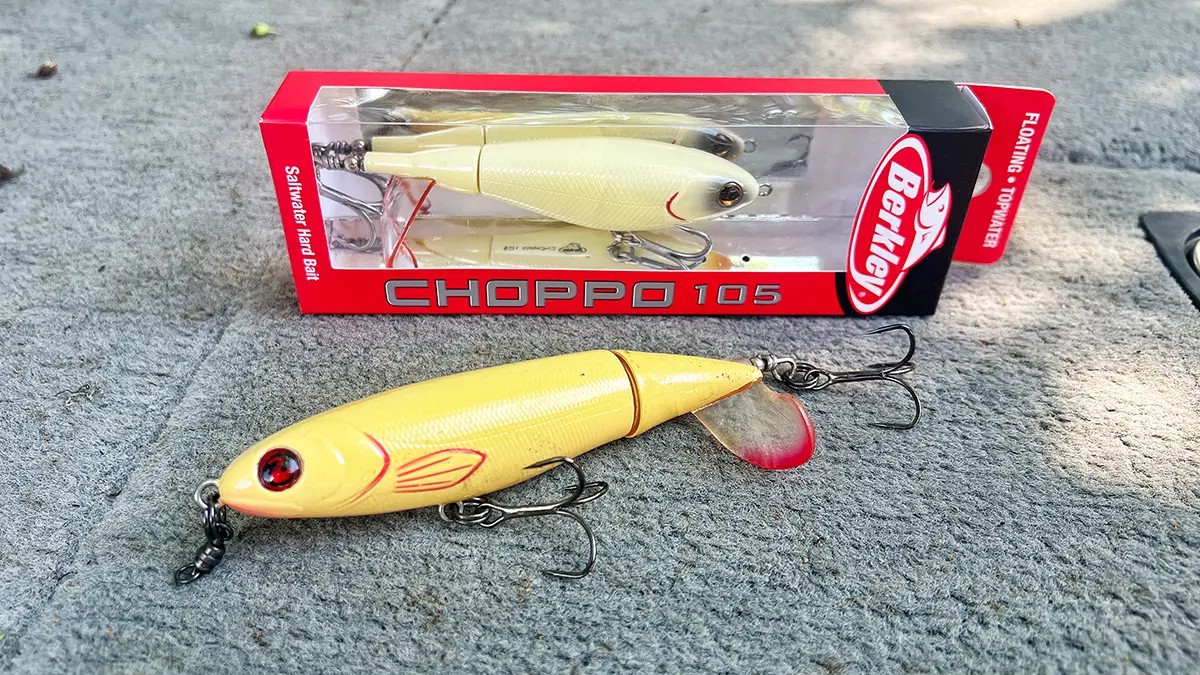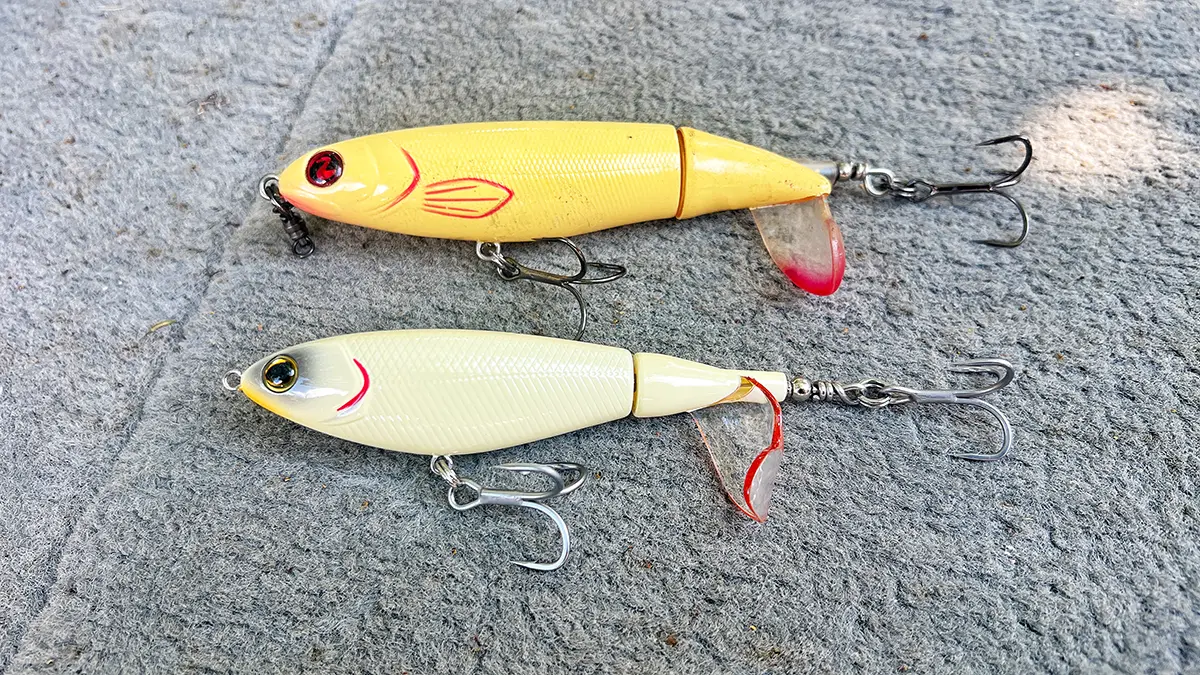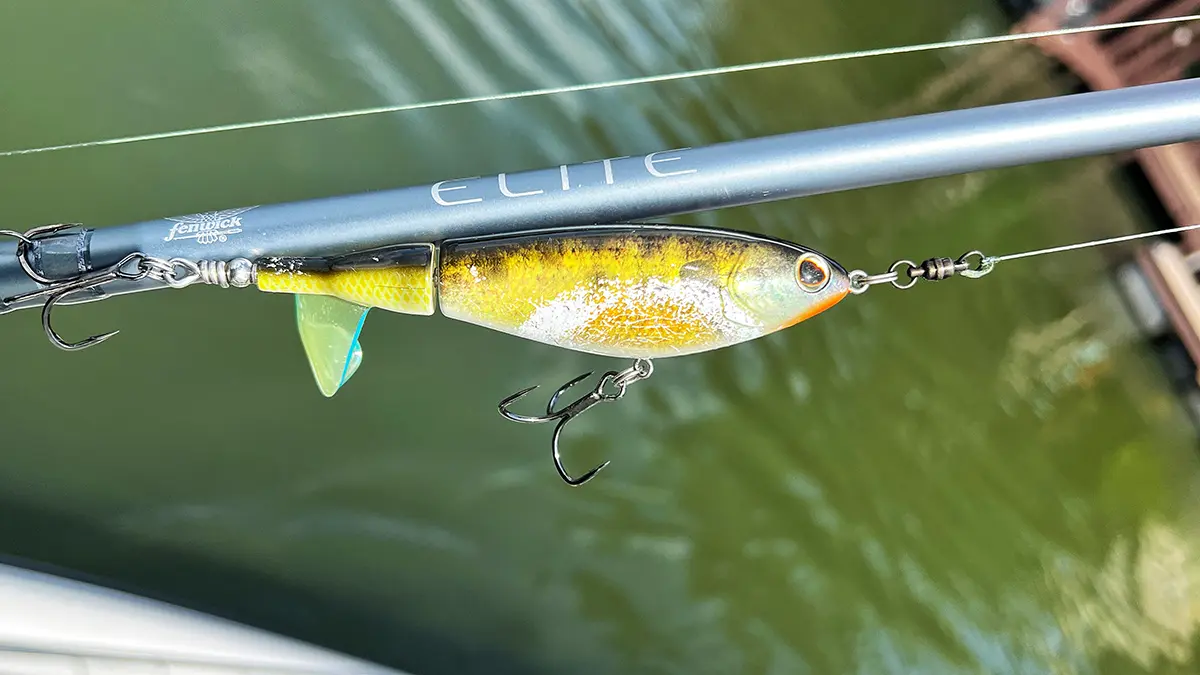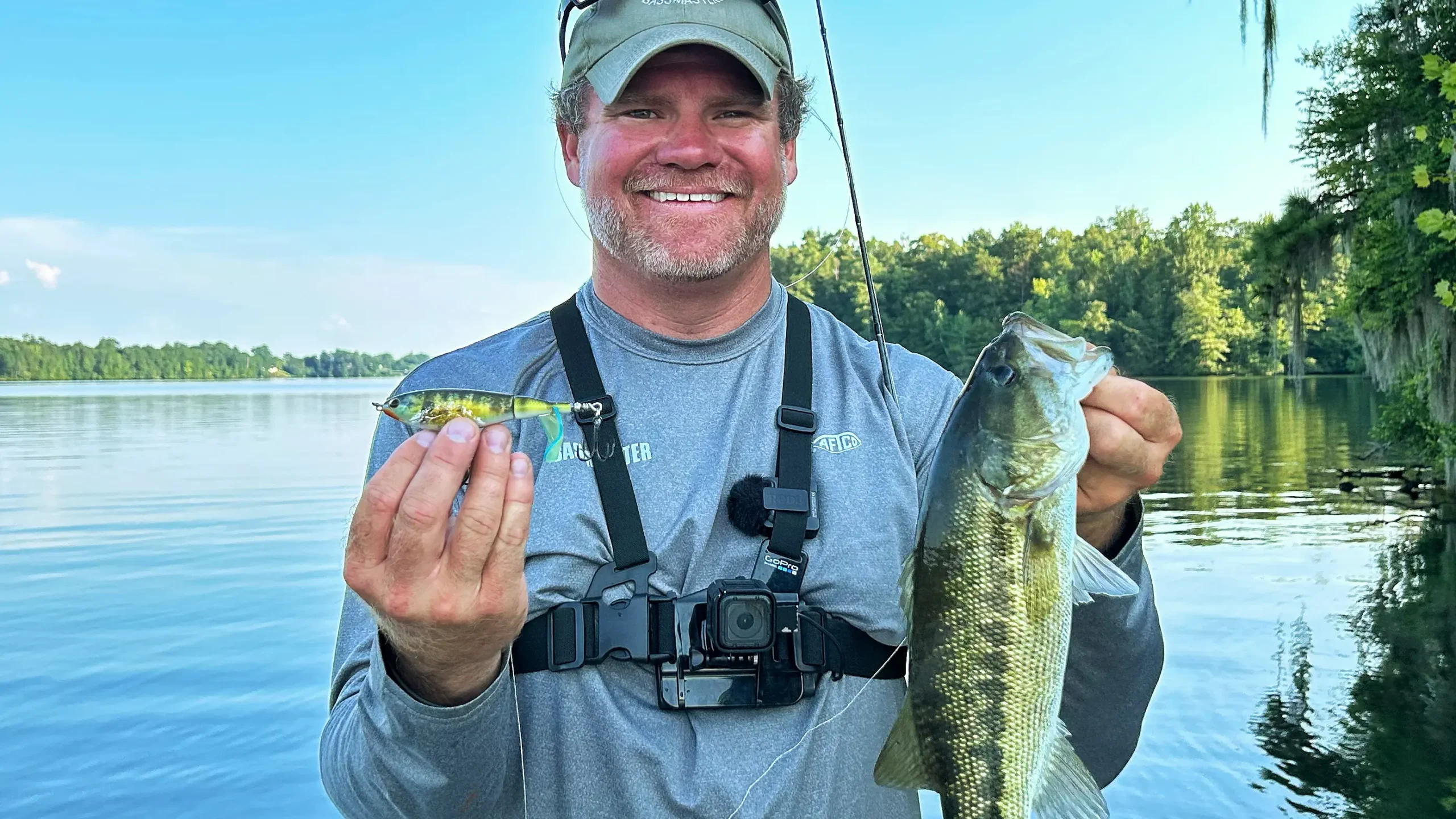Of all the awesome topwater baits that have come to market in the last several years, the River2Sea Whopper Plopper has undoubtedly been the most impactful. This revolutionary bait combines a buzzbait’s prop with the body of a Spook, putting the prop on the back to create a unique action, then dangles a couple big trebles beneath to maximize the hookup ratio.
The River2Sea Whopper Plopper is no doubt the first of its kind, designed specifically for targeting bass. However, as all revolutionary baits do, the Plopper spawned a whole new genre of lures. These were littered with direct knockoffs and sprinkled with a few successful attempts at reinventing the wheel—the latter able to make an already awesome bait even a little bit better.
The Berkley Choppo stands the tallest of the Plopper’s descendants; it brings a little something new to this style of fishing. It gets bit as much or maybe even more than the Plopper. Today, we’re going to talk about how to fish baits like these, while focusing some of our attention on what puts the Plopper and Choppo at the front of the pack in this bait category.

PLOPPER AND CHOPPO
I’ve been fishing with a Whopper Plopper for about a decade. I don’t remember the exact day I started fishing with it, but a buddy of mine put me on the bait before it even had its mainstream debut: when Chris Lane finished runner-up with a Plopper in the 2016 Elite Series event on Toledo Bend.
Before the world found out about the Plopper, it was an unbeatable bait. Bass had never seen it before and they annihilated it. After Lane did his damage with it, the bite died off rapidly. It was astonishing how quickly the fish grew conditioned to it. Within a few months, the massive blow ups had turned to near misses, with bass simply rolling on the bait and not getting the hooks.
Other baits emerged quickly, in an attempt to capitalize on the craze. Berkley seemed to wait patiently to see if the buzz would die down, while perfecting a version of their own in the meantime. In 2018, the Choppo was born.
THE CHOPPO DIFFERENCE
I didn’t fish the Choppo until recently. I had a lot of success with the Plopper and felt like I owed it a debt of loyalty as it was the original. However, when I started fishing the Choppo, I noticed that Berkley did something really smart with it. Though this is likely one of the most similar baits to the Plopper in overall design, the sizing of Berkley’s baits falls directly in the gaps in the Plopper sizes.
I’ve caught a lot of big fish on the 130-size Plopper, which measures 130 millimeters (or approximately 5 inches). I’ve also had a ton of fish blow up on that bait and not get it, from keepers that I could have used in tournaments all the way up to wary big bass. I tried stepping down to the next size (the Plopper 110), but that bait just didn’t generate the same number of bites. I found the smaller, 90mm version to be even less effective at getting big bites.
There’s a Choppo that I think Goldilocks would have been all about, though. The Choppo 105 (which is 4 and 1/8 inch) is considerably smaller than the 130 Plopper (5 inches), but it still has a heck of a chug to it. I’ve found this to be the perfect complement to the bigger Plopper, for those days when the bass just won’t commit to the 130. It’s even a bait I’ll start off with most of the time now, reserving the 130 for windier days when the larger bait is easier to fish and offers a little more drawing power.
FISHING PROP BAITS
If you’ve never fished a bait like this, here’s a quick rundown. These lures are extremely effective topwaters for covering water. They really shine when bass are a little more spread out in the shallows. You can put the trolling motor on 40% and chuck one of these down the bank in the summer, hoping to cross paths with a cruising wolf pack of bass or a bluegill bed. Targeting shady spots and tree tops are great ways to draw strikes too.
There’s no need to “work” these baits like you would a Spook or a popper. All you have to do is reel them in and let the tail do its thing. A steady retrieve—just fast enough to keep the tail turning—is best in late spring and early summer as the water starts to warm. However, once summer is in full swing, you can burn the bait along pretty quickly.
If you get around some cover or shade, it’s a good idea to slow your retrieve down a little to keep the bait in the strike zone as long as possible, but don’t stop it. The fish will eat it if they’re going to eat it with it moving continuously—that’s your best chance. You can add a little twitch here and there to add a burst of erratic action if you want, but otherwise keep the bait coming back steadily.
GEAR FOR FISHING PROP BAITS
Though you can fish these baits on monofilament, you really are better off with braid. The bigger versions weigh 3/4 to over an ounce, and braid handles launching baits this size better than mono. And these lures’ tendency to twist, especially at the start of the retrieve before they can pop back up to the surface, can wreak havoc with mono.
A few twists here and there create big problems over time, and can make a real mess with mono. But the effects aren’t as noticeable with braid, making it the better option. Still, you may need to cut your bait off at some point and drag your line behind the boat (if you’re able) in order to remove the line twists.
Another great trick involves adding a small swivel to the front of the bait. This cut line twist down about 70% for me, allowing me to fish three times as long without having to cut my bait off and work the twists out. Basically, I can fish a bait like this all day and not have to deal with the line twists until the trip is over.
A good 7 foot, 3 inch-plus medium-heavy rod is best for the Whopper Plopper 130. You can get by with a smaller, medium-heavy rod around 7 foot for the Choppo 105. The 7-footer is serviceable for the Plopper too, but that bait weighs nearly an ounce and a half, and most rods that size aren’t rated for a bait that heavy. So to cast the bait well without risking blowing the rod up, you’ll need a little bigger rod.
I like using 40-pound Sufix 832 for most prop bait work; 30 pound is a little light in my opinion. The thinner diameter makes it prone to digging into the line on the spool; but you can probably get by with it fishing the Choppo 105.
You’ll want a fast reel, something with a 7:1 gear ratio or higher. A 7.5:1 or even an 8:1 will allow you to bring your bait back at a good pace on the retrieve and then burn it back the last little bit between each cast. Over the course of a day’s fishing, this makes a big difference on how fatigued you are and you’re able to make dozens more casts. Keep in mind it only takes one cast to catch a giant on one of these baits.
Here are some solid gear recommendations:
- REEL: Abu Garcia Revo STX 8.1:1
- ROD: Fenwick Elite 7’1” M hvy/Mod fast
- LINE: 40# Sufix 832 Braided Line
- REEL: Lew’s Super Duty Speed Spool 7.5:1
- ROD: Fitzgerald Vursa Series 7’6” M hvy/Mod fast
- LINE: 40# Sufix 832 Braided Line
SWIVEL: VMC size 1 Black Stainless Steel Heavy-Duty Ball Bearing Swivel with Welded Rings
BUCKLE UP
Whopper Ploppers, Choppos and baits like them are still extremely effective lures for bass fishing. These topwaters create a lot of disturbance, imitating a struggling or fleeing baitfish. They’re capable of drawing the attention of a bass from a considerable distance.
You’ve got to make sure you have the right gear for this style of fishing, because the bass that bite these baits are often big and fishing these lures comes with a unique set of issues. Braid is best, be sure to use a rod that’s up to the task and choose a faster reel so that it can do most of the work for you. I’m confident you’ll have success fishing one of these baits on your next trip if you follow these tips.
















